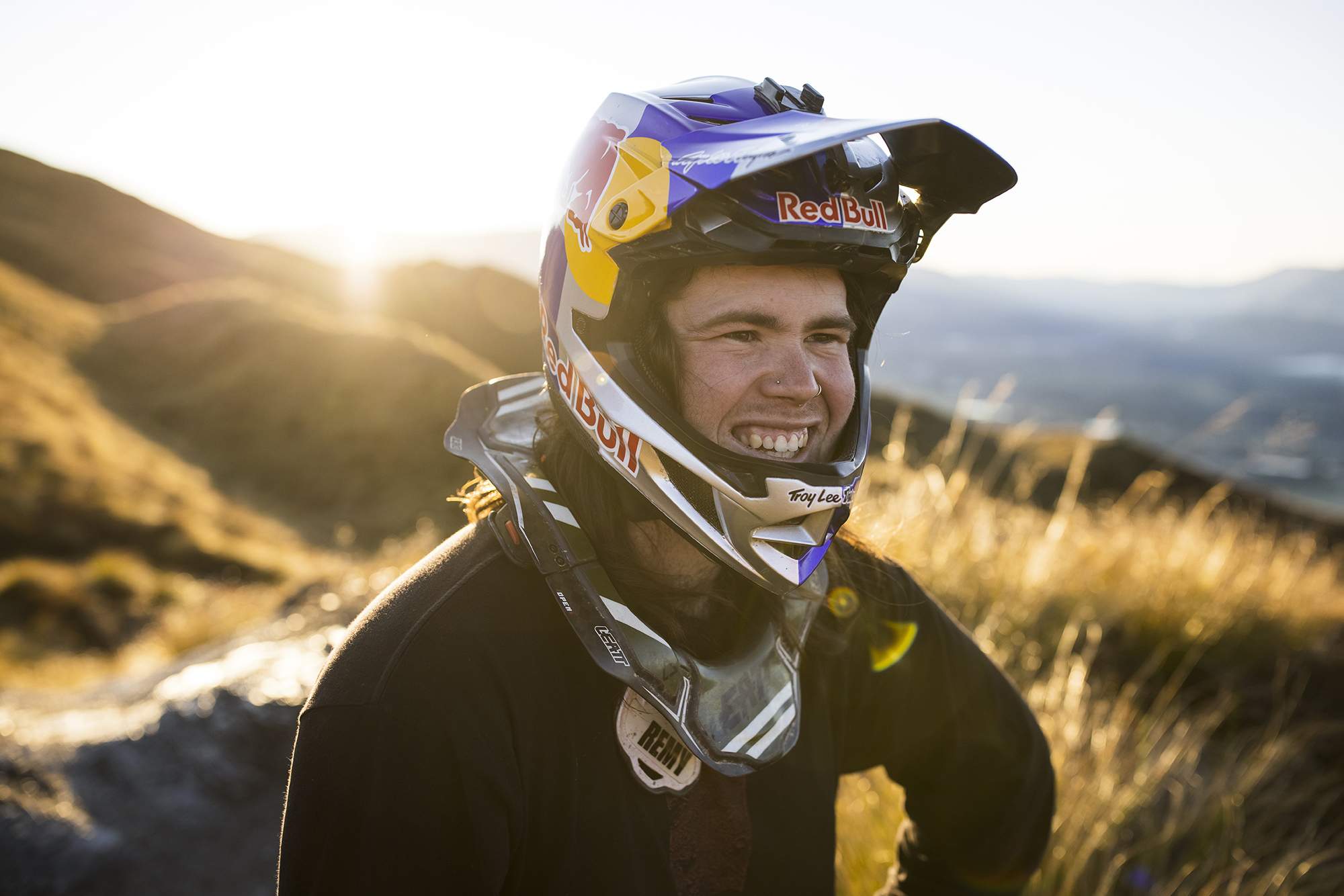There’s not many out there able to blur the boundaries of riding like Remy Morton. Chasing the dream to race World Cups from a very young age, his travels enlightened him to the simple fact that there is much more to riding than what happens on any given race weekend.
Not content with simply riding the best spots in the world, his passion to sculpt the earth into trails that showcase just how epic riding is, be it on big wheels or small, has brought world wide attention. With his addition to the esteemed Red Bull roster, many wondered how a non-racer or slope competitor would fit in, but in typical Remy fashion, a project was born to combine and showcase the full spectrum of his skills across riding and building, a trail you can ride yourself at Boomerang Bike Park.
The crew from The Head Angle and the mag sat down with Remy to get some insights into his life growing up, making trail building a career, huge jumps, bike design and the future of MTB itself. So buckle yourself in and get set to gain a ton of insight into one of MTB’s most interesting young minds…
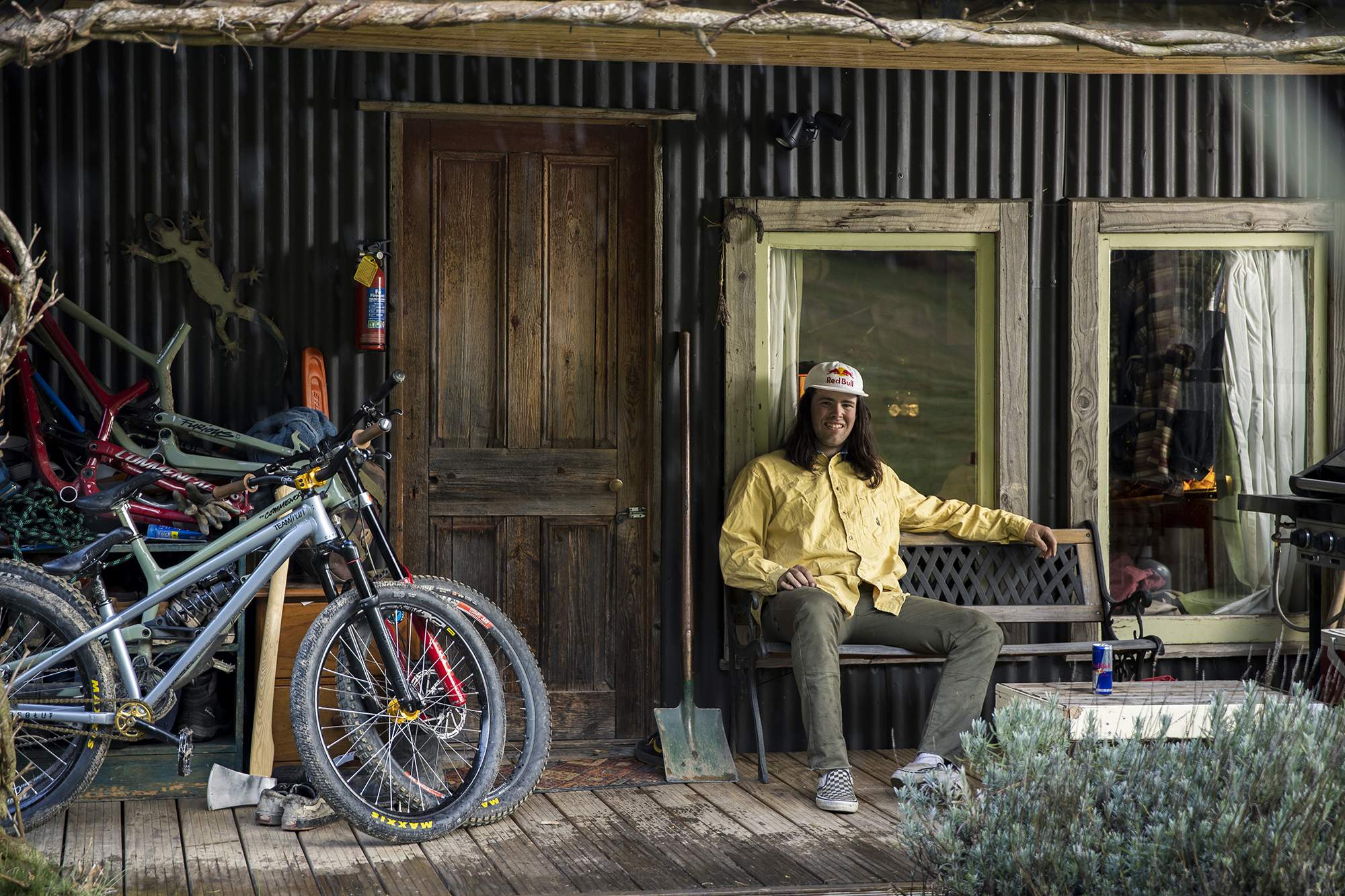 You’ve managed to cross all the boundaries in mountain biking, from racing world cups to freeride, alongside trail building, but you’ve also blown the doors off BMX in some ways. You’ve really carved a niche for yourself. So if we go back to the start, where did riding start for you?
You’ve managed to cross all the boundaries in mountain biking, from racing world cups to freeride, alongside trail building, but you’ve also blown the doors off BMX in some ways. You’ve really carved a niche for yourself. So if we go back to the start, where did riding start for you?
It started as far back as I can remember. Always had bikes from when I was a toddler and we were always digging and riding. That was the story of my life. I got a Pee Wee 50 and then I had a pretty hard crash on that when I was three years old. After that my Dad got me a little BMX, a Redline, and got me into BMX racing and training nights and stuff when I was just about to turn four on a little micro mini. It kind of went from there.
So from BMX racing, how did MTB happen, there’s no mini MTB racing that I know of?
I was too young to race legally under the Mountain Bike Australia rules, but my Dad was the club president for The Gold Coast Mountain Bike Club. They had to get the president of Mountain Bike Australia at the time to come and do a check or something, to watch me ride. It was pretty funny. Little tests. And then yeah, from then, downhill became my priority. I just liked going fast and I could do that. I went to under 15’s pretty quick. And then all of a sudden when I was 12, I was racing in under 17’s and by the time I was 14, I was in under 19’s. And then at 15 I was racing elite at all our local Queensland rounds. My Dad was so into it as well. So we’re all riding down together and I’d done a few overseas trips by that point. Yeah. It kind of just came all together naturally, it was pretty cool because it definitely felt like no pressure at all. The progression was just happening with time.
So from a pretty young age, you were aiming to get on the Australian team and travel to Europe to race world cups?
Growing up, I watched all the mountain bike movies, and it was kind of around that boom of Sam Hill, Nathan Rennie, and Chris Kovarik. And it was pretty cool because I grew up on the Gold Coast, and Nathan and Chris were both living around the same place. I was probably in the car like, “Dad, look, that’s Nathan”, just frothing over it. I think it was pretty inspiring seeing the guys who were the current world champions, it sort of just seemed normal just seeing them most weekends riding with their mates. From then on I always told Dad that’s what I was going to do.
So from QLD races to your first trips overseas to Europe to race, it didn’t take long?
In 2014, the year before I was a junior, I was on the NS Dynamics team, which is a suspension shop in Brisbane. Back then it was Aaron and Nigel. Nigel was Stevie Smith’s mechanic on DaVinci Global. DaVinci were supporting me as a kind of undercover rider for them through the team, they got me over to Europe the year before I was a junior to do some iXS Cups and to do some sweep riding at the World Cups to get a feel of it. Nigel said it would really benefit my riding. Dad was super supportive and jumped on and we went over for a family trip, travelled around and did a bunch of races. From there I met the guys from the Polygon UI team and signed with them for 2015, as a first year junior. So I guess that really fast tracked a lot of things. It was the dream. I was getting flown around the world to race, and it was crazy.
That situation didn’t pan out as well as we had planned though. I had a three year contract that ended up getting cut short after eight months. I just didn’t really get along with the managers. We didn’t agree on everything.
It went from full factory to full privateer pretty quick.
That was the year that I travelled with Baxter, that following year. So that was a pretty crazy curve of events, from the biggest pit truck at the World Cups, to all of a sudden sleeping in the van with Baxter in car parks. It made us realise what we wanted out of riding. For me, growing up watching all the World Cup movies, all the Earths, all the Super 8s, all those kind of DVDs, it wasn’t the environment that I imagined it being. It seemed like a lifestyle kind of sport, whereas it’s definitely a very professional sport. We kind of took off on our own path and decided to be ourselves and do what we did. Which has worked out now. But for a few years there, there were some empty times, because it went from a whole life goal of getting to the World Cups to all of a sudden realising it wasn’t what we actually wanted.
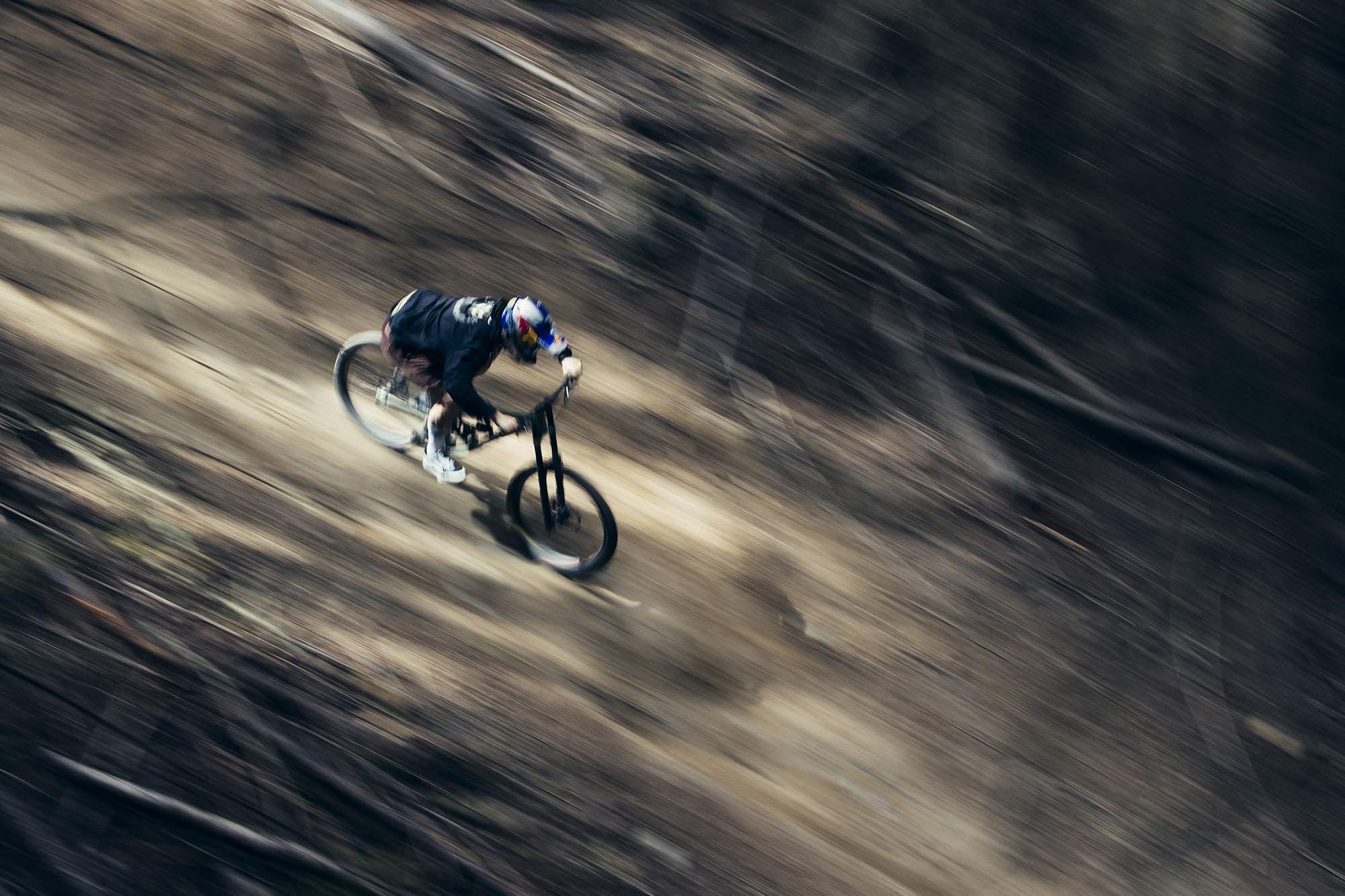 So when you were over in Europe racing World Cups, you obviously got a taste of bike parks and trails that were built for other than just getting downhill as fast as you could.
So when you were over in Europe racing World Cups, you obviously got a taste of bike parks and trails that were built for other than just getting downhill as fast as you could.
I definitely got a taste of it in Whistler the year before I raced World Cups, but it wasn’t really a focus. It was just more like, “Oh, that’s sick.” Like riding A-Line or Dirt Merchant or something. But then I was still really equally as stoked on the crazy, rough downhill tracks. I just loved going fast and getting loose, and drifting, and it didn’t really stand out that much. And then I think it was the year that me and Baxter travelled. We based in Morzine for a while and were pretty much just riding jump trails every day. We did a few more World Cups and then after World Champs, we went to the UK and did a trails trip and we rode just BMX trails. I had a BMX and he had his hardtail. And that was, I think what really changed our outlook on a lot of things. That was the time where it went from racing downhill to all of a sudden we wanted to ride jumps. To all of a sudden we were focusing on bike park riding. I thought what I’d always wanted was to be a pro-rider and have all these sponsors, but that actually wasn’t what I wanted. I wanted to be a bike rider. If I make a salary out of it, it’s a bonus.
At the end of the day, I want to be riding the products that I want, and I want to be doing the shit that I want with no expectations…
When was the kick for you to go, “Yeah. Okay. I could get paid to build some trails”?
When I was young, my Dad didn’t work for two years. He was riding and he had a mate’s Bobcat and was building jumps in our backyard for us. I’d get home from school every day and there’d be new jumps. It got to the point where there was quite a few jumps in the yard. And then our neighbour was working for a civil company and he was like, “Oh, I’ve got some landfill. Do you guys want some dirt to make some jumps? And they ended up dropping 350 truckloads of dirt. Over the years it changed from having a set of jumps that you had to pedal from the top of my street, bunny-hop into the driveway and pedal down the driveway past the house, to slowly progressing to having a set of real trails. By the age of 12, I was living the trails lifestyle, I was always down the back in the trees, digging jumps, building, watering, as you do at the jumps. And then I decided I wanted to be more in the woods after seeing quite a few cool spots around the place. So I built this cool pump track zone down in a reserve behind my house.
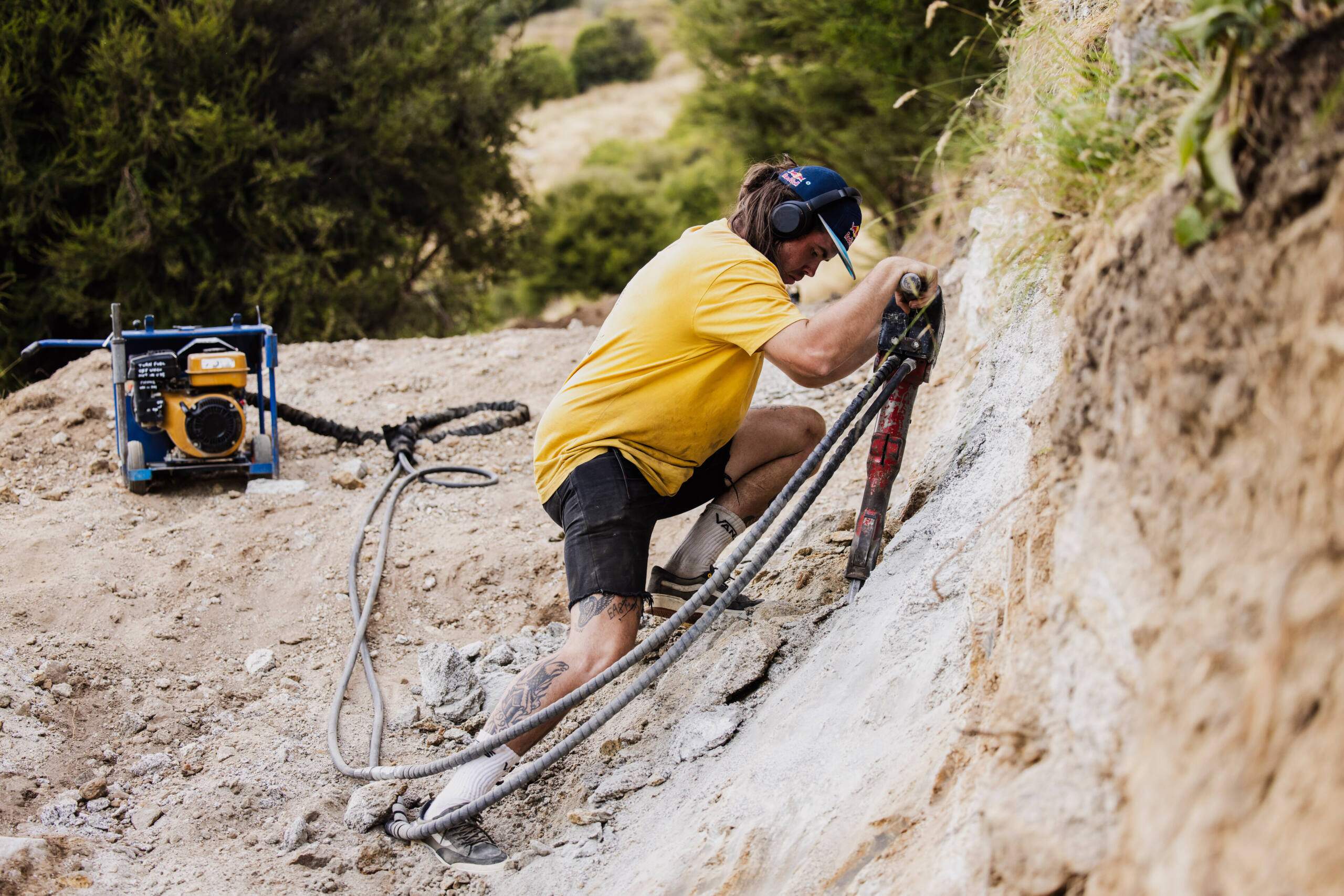 Pump tracks became hot property real quick, and trail building went from almost unknown to its own industry. How did it become a career option for you?
Pump tracks became hot property real quick, and trail building went from almost unknown to its own industry. How did it become a career option for you?
I think it was right when Instagram started, someone saw photos or videos of this pump track, it would have been when I was 15. I was working in a bike shop at the time. I left school when I was 14 and was working in an online warehouse for a bike shop full-time. I got this message from someone’s friends saying, ‘hey, we saw this pump track Remy’s built. Would he want to build one in South Australia for a job through this company?’ I flew down and it went from just a one-off job to progressing from there. I was 15 in South Australia, by myself, doing this job with some mates. I got to know Garry and the crew at TrailScapes. I worked for them for a little while, did a few odd jobs up in Queensland and then I just started meeting people. I got a job for Dirt Art, worked for them for a year or so. I was working with Nathan then, which was a real trip. Because it went from looking up to Nathan my whole life, to all of a sudden I was working with him. It was pretty sick. And then I worked with World Trail. So I swapped and changed through a lot of different companies. And then it just all fell into place really, mainly because usually there’s a boss like Garry, he’s been in the position of a rider and he understands and he’d be, ‘fair enough, not going to stop you from going to Europe’. So it’s a pretty lenient job. So that’s how it became a career, it just fell into place through a text message.
It’s not just here in Aus though, you’ve been shaping dirt across the globe right?
It wasn’t until the last three years that I started helping with some bigger jobs, like Crankworx or with Nico Vink and some of the Fest stuff. It’s started becoming more of an actual company.
Shaping dirt for a local pump track is one thing, but shifting the huge amount of dirt needed for Fest is another. How big are the jumps there and how much dirt goes into one of them?
A lot. That’s why those jumps have been in different countries, in Belgium or South Africa. I’m pretty sure someone told me that at the South African one they had to get a mining permit for it, because they’ve moved so much dirt. It’s actually pretty unexplainable, how much dirt there is there. Until you go there and see it. It’s like anything you see on the internet, it looks big on the videos, but then when you’re sitting there in a 20 ton digger, and it still looks big, you’re, whoa!
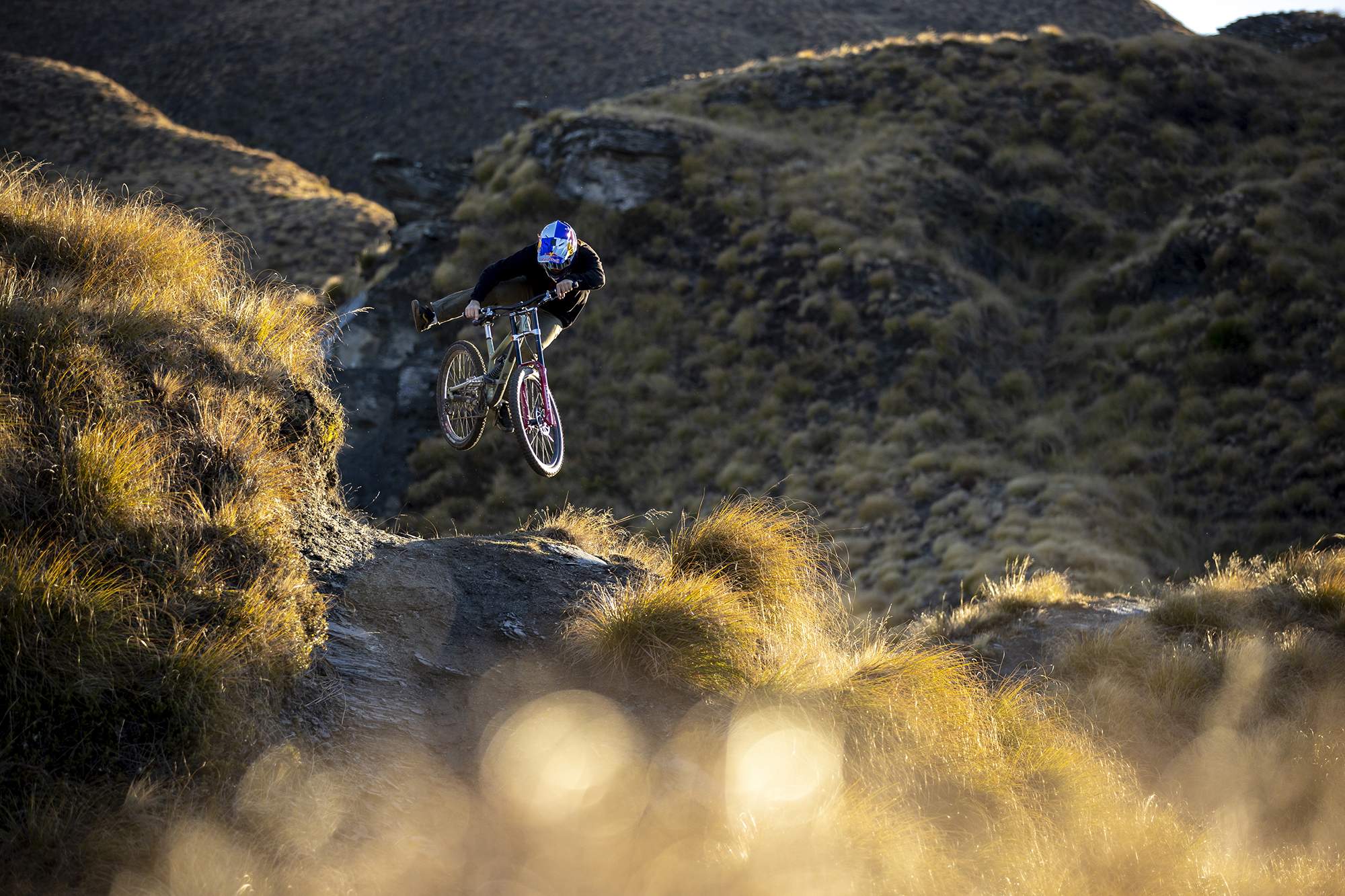 Are you hitting the things you build first?
Are you hitting the things you build first?
Definitely, usually in the first few riders. I used to be really confident with testing hits and then a few years ago I had that crash at Loose Fest in Belgium and I lost a lot of confidence. I really struggle with trusting my speed now on jumps, without following someone in or at least watching someone else hit it. Even if I fully know what to do, it’s just a weird mental block that I have now. It’s getting better and I think especially the last year, since I took my chain off my downhill bike, it helps so much. Because it’s eliminated one thing that I can do in a jump. Now I can only brake, I can’t decide if I want to pedal. So it’s making me a bit more confident.
Putting in a half-ass crank in before a big gap is never going to go well.
Yeah, exactly.
You’ve been pushing some new ideas in your mountain bike builds. Are you working on new parts? Give us a little insight into what you want to change up on mountain bikes?
It’s definitely something that I’ve been working on for a while, just different ideas in my head and trying to work it out… I guess that’s the unique thing about digging. If you get into the building, you can build anything. But then the next step is you need the equipment to ride it on. Right now, it’s hard because the type of riding that I really want to push, the big bikes are still not made to grind, or handle steep lips like a slope bike can. I’ve been working with a dude down in Melbourne, Mick Williams, and we’ve been working on a few different concepts and designs and ways that we can change things. I can’t say too much now, but it’s definitely something I’ve got in the works. That’s the beauty about riding. You can really be yourself and make and do what you want to do. But it’s a pretty tough balance, especially with social media and everything now.
I think the way that companies and websites and news and everything runs, it really forces people into believing something and running shit that you don’t need to run.
So where do you see MTB heading?
Mountain biking and the bikes are coming to a point where it’s going to change a lot in the next few years. And I think with the stuff that I’m working on changing, as well as a few others, it’s going to really excel. It’s exciting to see that sort of shit starting to pop up, what I’m doing, what Baxter’s doing, what Nico Vinks doing. Mountain biking is becoming a lot more respected from other parts of the sporting world. It was always so separated. My whole life growing up, I had my trails friends and my downhill friends. And now the trail and BMX, salty ass dudes that always said ‘why do you ride those things?’, now they’re all starting to ride them. And they’re all stoked on this new generation of things. Which is pretty cool to see. It gives me faith, that we’re starting to push it in a good direction.
It happened in a bunch of other sports, snowboarding went from being kooky as to rockstar, same with skateboarding, and definitely BMX back in it’s early years. I guess that’s going to happen in mountain biking, it’s evolution?
Fully. The way I always look at it, I always think of Lords of Dogtown, the movie. When you watch that, those dudes wearing cutoffs and normal clothes turn up at the established skating comp where they’re all going around in circles, in Lycra and shit, and in crazy colours. The same thing happened I guess in freestyle BMX. And it happens in every sport. But mountain bikes is still so much younger, that I think it’s really about to go through that major change of a lot of more younger dudes that are a bit more rebellious and they’re, ‘why do we want to wear these wacky riding clothes on our bikes?’
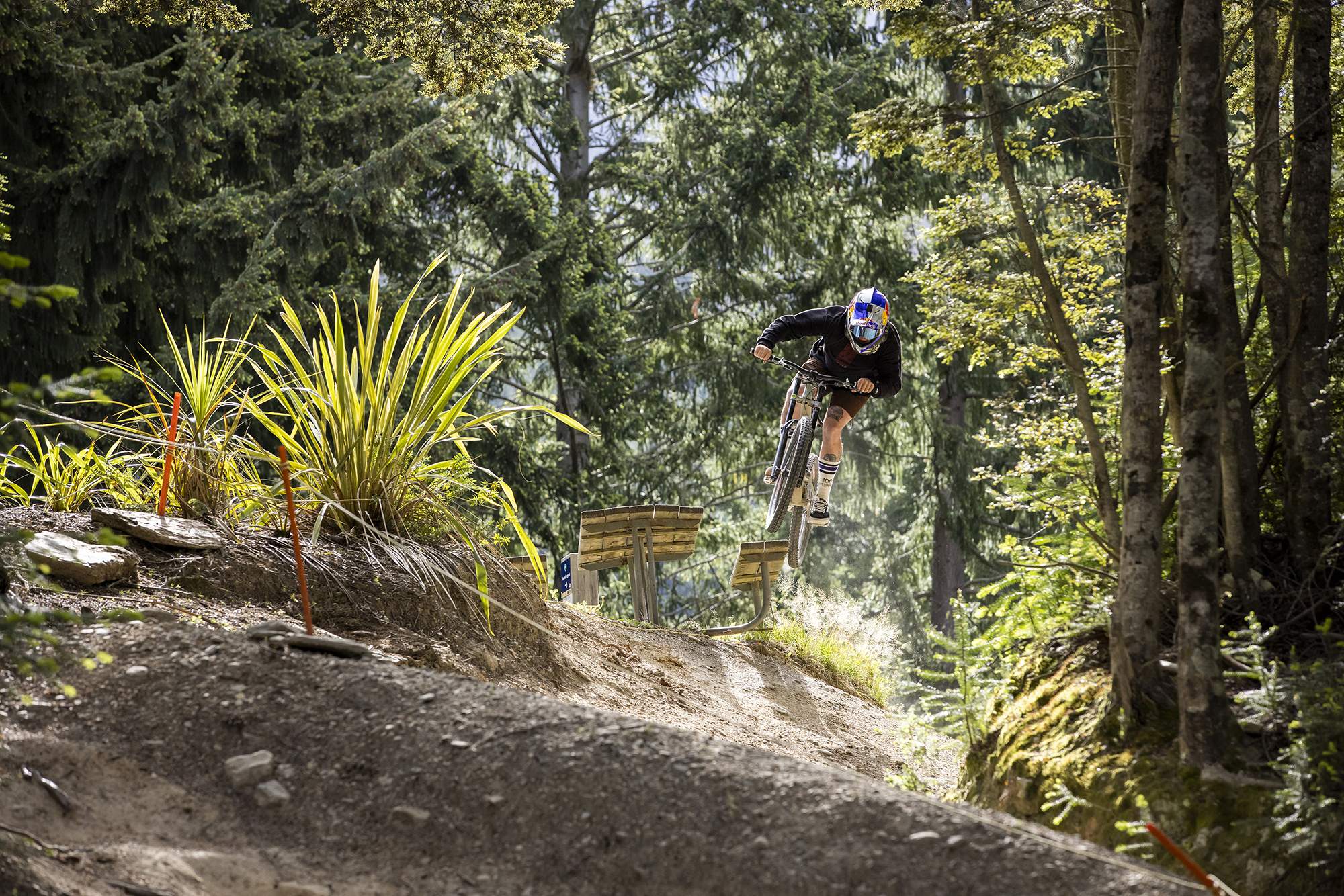 You’re in the epicenter of MTB in the southern hemisphere somewhat, in Queenstown NZ. So every second person’s got a mountain bike.
You’re in the epicenter of MTB in the southern hemisphere somewhat, in Queenstown NZ. So every second person’s got a mountain bike.
Yeah. You’re a skier, snowboarder or bike rider here. And that’s why I moved here. You’re always surrounded by it. It’s actually pretty insane that it’s becoming just a normal sport now. All the kids are doing it. Mum and Dads are doing it. It’s a trip, I like it. Every time I go into town, to a pub, there’s like a hundred grand worth of Enduro bikes out the front not locked up. Just like in the rack. It’s just normal. No one cares.
How long you’ve been down there in Queenstown?
On and off for seven years now, I did my first summer in 2015. I was just coming for three months a year, and then in 2017, I had that bad accident at LooseFest. And then, I really wanted to get back riding and I was kind of like, well, if I want to get back to riding and get to the level I want I need to have that full range of bike park to really kind of work my way back. Since about 2018, I’ve been here permanently, pretty much.
So what pays the bills on a daily basis for you there now?
It’s always been trail building for work, through Elevate Trail Building. But, a few months ago, my friend Jacob and I have started our own trail building company, Flux Trail. So, that’s kind of like a dream come true. We’re just working for ourselves and riding and that’s pretty awesome.
With your big crashes in the past, you have some very solid opinions on protection?
I’ve got a lot of grief on social media and YouTube comments and stuff over me and pads. A lot of people say, ‘oh, why aren’t you wearing knee pads and stuff? I never wore knee pads riding dirt jumps, but I’m running the best helmet you can buy and I’m running a neck brace. And when I ride the big jumps, I always wear a chest plate. And to me, that’s the most important part of my body, that’s what I want to protect. That’s where I’ve had all of my worst injuries, they’ve all been internal injuries and my neck and collar bones and stuff. So, I really try to push that you don’t need all this fancy bling shit to be a good rider or to be safe. You just wear what you want to wear but make sure you’ve covered and spent the money on the important stuff.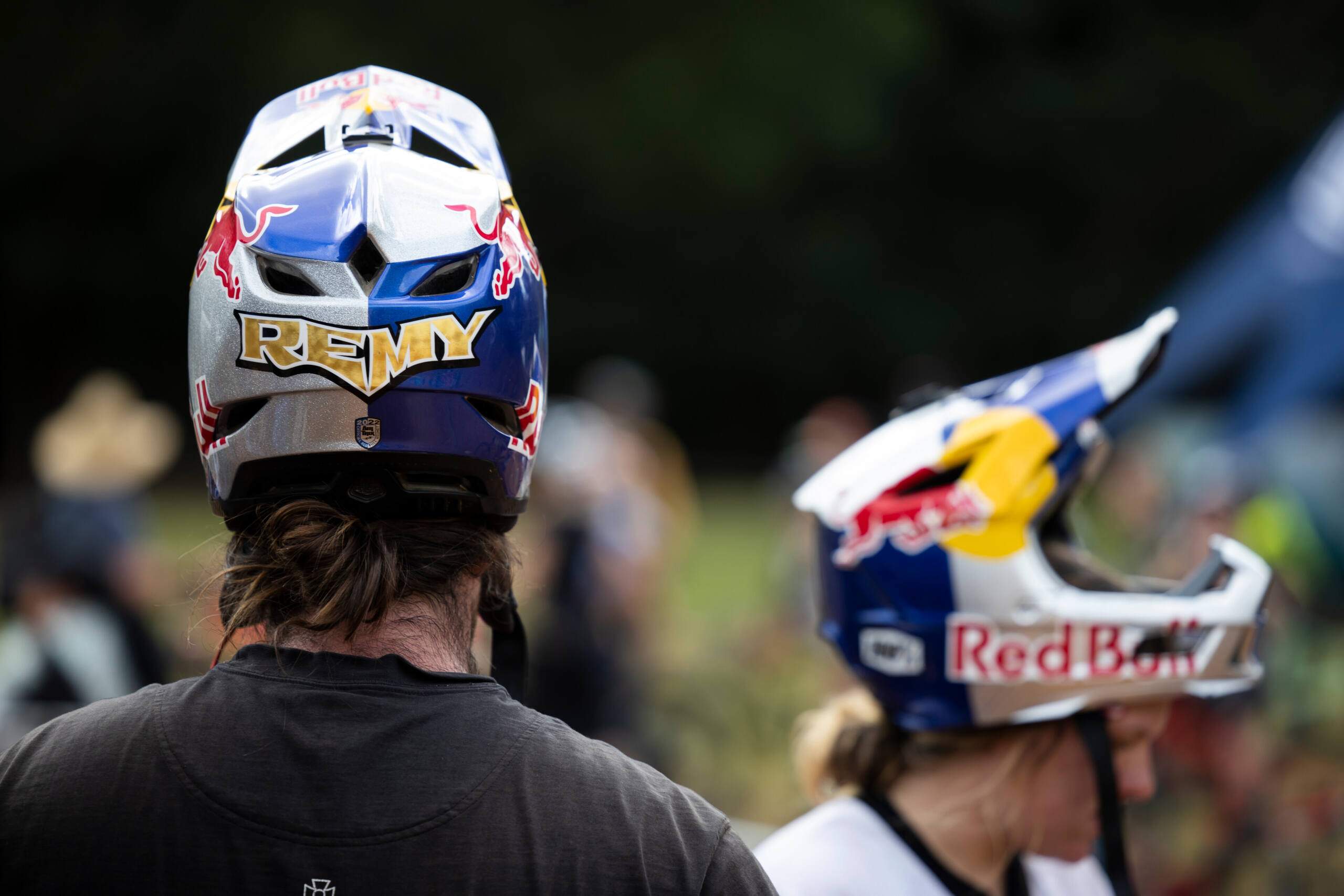
To me, a helmet, that’s all that really matters on a bike. Your bike should work good, your helmet should be working good. Other than that, like if you hurt your knee, you’re going to live.
It’s like anything. You want to feel comfortable doing what you’re doing.
So, you’re no longer just a racer, and you’re not a regular slope comp dude, Red Bull had plans thou, first the helmet and then the content creation began! You’ve just done a project up in Queensland at Boomerang with them?
The boys from Red Bull Sydney came up with the concept of doing 7K in seven days, which kind of tied a bit of everything in; my BMX digging side and my actual trail building side as well as my riding. I wanted to make sure that it was in a location that it could give back to the community and the guys at the Boomerang Farm were super, super keen on it and it suits that park. We did a little scout mission, worked out the best spot on the mountain to build. Basically I was “I want to make a BMX inspired line for downhill bikes” which is how I want to push my riding in the next few years. It’s kind of a mix of the two and who I am. I was stoked that it shows that it’s real too. I think that the testing side of things is definitely a hidden part on a lot of videos. You see the glory at the end, but you don’t see what the riders actually spent to make it happen, like when I went down, that really, really hurt, actually.
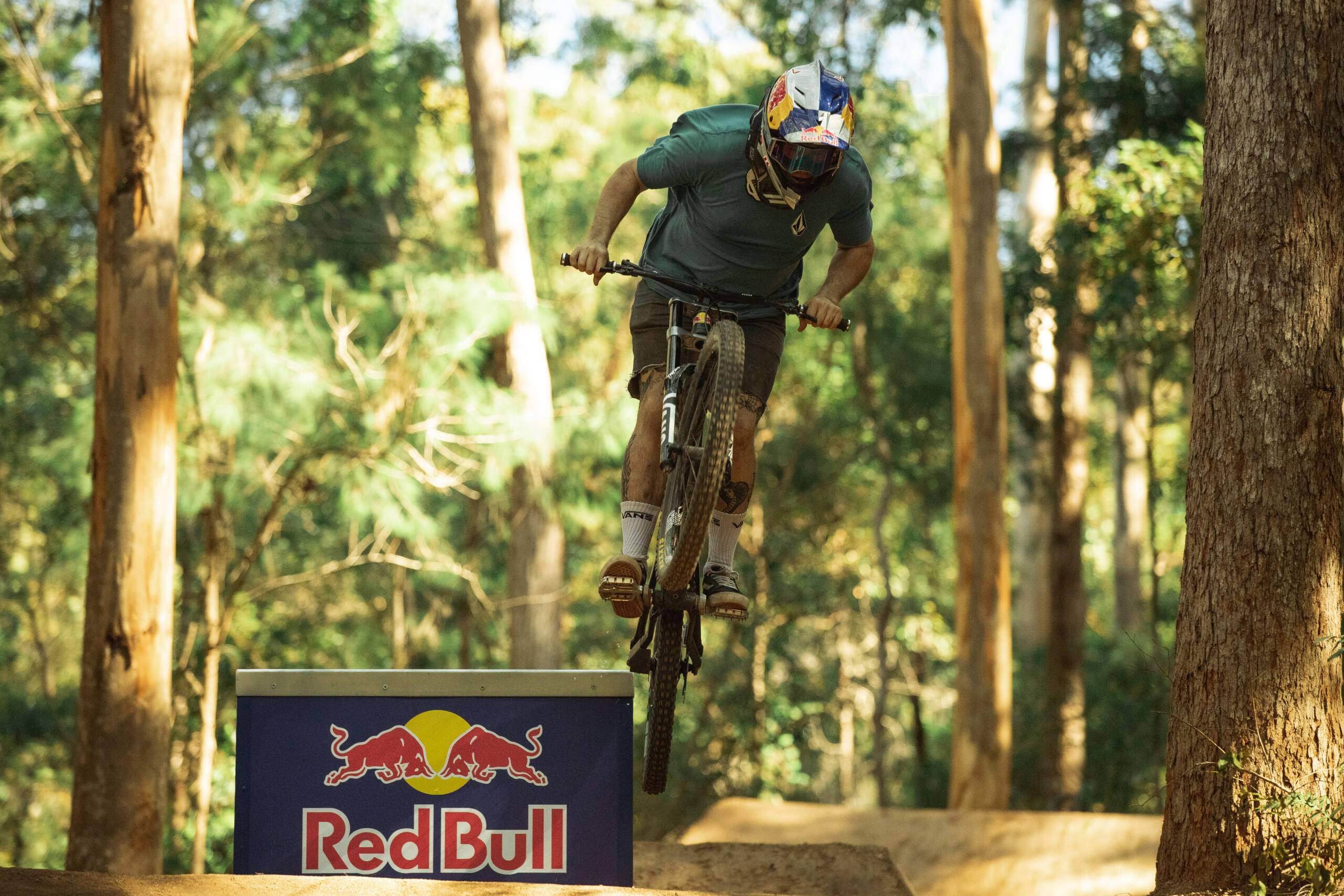
You added some trail features a lil out of the ordinary to say the least! Is the grind box going to stay there?
Yep. That’s still there. That’s something that I’ve got a lot of drawings of, it’s something I’ve been working on for a while now, I’m getting a lot of the inspiration for the builds, between BMX and snowboarding. Like that box, you don’t have to grind it to ride it. Like you could use it as a manual pad, you could use it for a nose bonk, you could tire slide it, slide the side coping, you can gap the whole thing. It’s not a specific box. And it was pretty cool to see the different riders that helped test and ride it, but in a different way, it was sick to see. Maybe if I get my shit together and build a better grind plate that works with a chain, more people might be interested in the grinding part! I was stoked to trial it in that zone and I think it’s really cool to give it to such a small mountain bike community. They get to get a taste of what’s happening, like there’s kids there that have never even travelled interstate and all of a sudden they see something that’s at global progression level. I think it’s pretty cool even if they can’t ride it. It’s just to see it and get ideas of what is achievable if they want to. And they’ll have a crack and in six months they’ll be hitting it.
It looks like one hella fun trail that’s rideable for more than just you and the worlds best?
Exactly. That was a big goal on that build. I wanted to make it not gnarly big, but I definitely wanted it to be gnarly technical with a lot of features that I know no one’s used to riding. I’ve never seen a wall ride built like that, for example. And a few of those features are so different, but they’re not too gnarly. So it’s really cool to see that the kids there at the moment are struggling with it, which I’m fine. The riding is going to step up a level from where we’re currently at, I really wanted to give them something they need to work up to.
So what’s in store for the coming year?
The next goal is, well, I want to build some really gnarly jumps. Something at the level of LooseFest and DarkFest. But I want to build something with my own taste at that kind of level. It doesn’t have to actually be the biggest. I want to be riding stuff that big every day and I think it would be especially cool to bring something like that to Australia or New Zealand, because it’s something that we’ve never actually had here. It’s not a very achievable goal for a lot of the kids because they’ve got nothing to actually see in real life. But if there’s one down here that they don’t have to travel to Europe to get to, progression will happen.
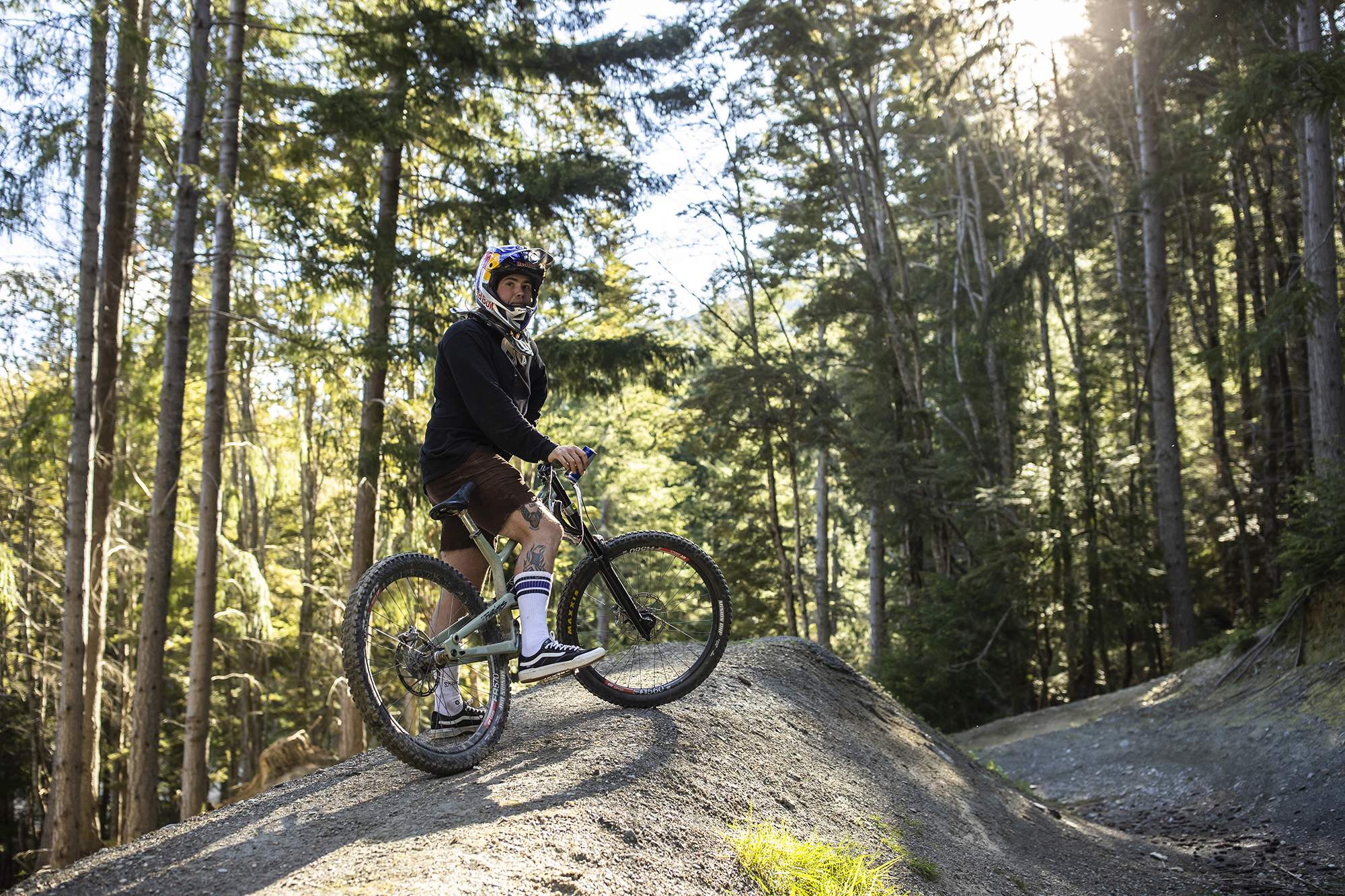 Build it and they will come right?
Build it and they will come right?
Yep. Like if you can knock off work or school and go ride 80 foot sets, it’s just going to make your day. If you are doing that shit daily, you’re going to be happy. Regardless of the day you’ve had before you are going to go to sleep stoked. We know how to ride bikes, we know how to jump a jump. It’s just bigger and faster. We just need to build it and do it. It’s just something that’s not really a common sight in Mountain biking at the moment.
‘Yep. Like if you can knock off work and go ride 80 foot sets, it’s just going to make your day.’
When you were younger, the legend Dane Searles, RIP, hit his crazy big line, did that plant some sort of seed? No one has gone that big on a BMX since.
Yeah, definitely a legend. I watched that video in school a lot, because he was living on the Gold Coast at the time. So it was like local legend, all our schoolmates all watched him. But it didn’t really drive me until a little bit later on, after Dane passed, when Josh Stead was doing the 419 project. He contacted my Dad, because Dad was doing mountain bike club stuff and he asked if he could come check out this property with us. I just remember it so clearly in my head standing top of this grass hill that woulda been so fast on a downhill bike. And he was like, “yeah, I reckon this will work. I want to be going between 70 and 90kmh into the big jump.” I remember thinking someone that has that mindset is so badass. I guess that led on from Dane. That’s honestly been a thought that runs through my head once a week. I just think of him saying that like, no shit. If he was thinking of doing that on a BMX, what can I do on a downhill bike, you know? That he was thinking that over 10 years ago then surely with the technology that’s in the bikes now and the way the riding’s progressed since, surely we can make it happen. So there was definitely big motivation from Dane.
Do you think his project influenced MTB beyond just you.
I think that whole project of Dane’s changed mountain biking. I was talking to Andreu Lacondeguy about it this year in Europe. He went and rode that spot with Dane and he was saying he couldn’t believe it when he turned up. They were the biggest jumps he had ever seen. At the time MTBs were jumping a lot bigger than BMX. And then all of a sudden, this dude’s jumping bigger shit than anyone ever on a BMX. I think that was a massive motivation to the way that Andreu started riding and the way that Fest started and that really, really motivated mountain bikers to take it to the next level.
Honestly, I think Dane changed not only BMX, he changed bike riding.
You can watch the full interview here [R]




